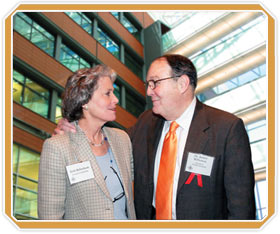The University of Texas Health Science Center at Houston
 |
James T. Willerson, M.D., President of The University of Texas Health Science Center at Houston, congratulates Beth Robertson, New Frontiers Campaign Chair, on the successful completion of the initiative to raise funds for the $120 million Fayez S. Sarofim Research Building for The Brown Foundation Institute of Molecular Medicine for the Prevention of Human Diseases. The campaign not only funded construction of the eye-catching facility, but also generated 27 permanent endowments.
(Photos by John Everett and Wendy K. Mohon)
|
Endowments Key to New Frontiers Campaign
The University of Texas Health Science Center at Houston creates 27 endowments for The Brown Foundation Institute of Molecular Medicine for the Prevention of Human Diseases
By Wendy K. Mohon
The University of Texas Health Science Center at Houston�s (UTHSCH) New Frontiers Campaign, successfully completed in January 2006, accomplished more than just the impressive task of funding The Fayez S. Sarofim Research Building for The Brown Foundation Institute of Molecular Medicine for the Prevention of Human Diseases (IMM). The campaign established more than two dozen endowments to sustain the IMM for years to come.
�Endowments were the real essence of the New Frontiers Campaign,� said Beth Robertson, Campaign Chair. �While the majority of the campaign funds built extraordinary research space housed in a handsome building, the campaign was more about the �bright minds� that fill the building than bricks and mortar.�
One of the 27 endowed positions created by the campaign was the Annie and Bob Graham Distinguished Chair in Stem Cell Biology, invested in the Long Term Fund and funded by native Houstonian Robert �Bob� Graham and his wife, Laurel �Annie� Graham.
�We believe in the mission of the UT Health Science Center and knew that this was the right thing to do,� Annie Graham said. The couple�s $1 million gift will create a permanent endowment, the generated funds from which will be used to further stem cell research efforts at the IMM. Stem cells could be used in transplantation medicine, to regenerate tissues, and to provide treatments for a number of chronic diseases, including heart and vascular disease.
C. Thomas Caskey, M.D., Chief Operating Officer of the IMM, says endowments, such as the one established by the Grahams, are vital to recruitment efforts at the IMM.
�The recruitment of leaders is critical for program expansion to mentor bright, rising young faculty at a time of international competition for talent,� Caskey said. �The endowed chair indicates the IMM�s commitment to the field and thus facilitates recruitment of the best.�
James T. Willerson, M.D., President of the Health Science Center, added that endowments help pave the way toward the vision of creating a cutting-edge research facility populated with leaders in the field of molecular medicine.
�The newly completed building for the IMM provides a superior environment for research, collaboration and education,� Willerson said. �Endowments from our generous supporters help us draw the world�s best scientific minds here to develop exciting new treatments, preventions and cures for a wide range of diseases afflicting our population.�
Robertson added that endowments are an attractive option for many donors who wish to make a gift that creates a lasting legacy.
�By establishing an endowed faculty position or an endowed lectures series, donors know that their gift will have long-lasting and far-reaching impact,� Robertson added.��The groundbreaking research within The Brown Foundation IMM creates a legacy that is very appealing.� The donor is a significant player in the quest to conquer our society�s most common diseases. It is a gift that keeps on giving�the best of all gifts.�